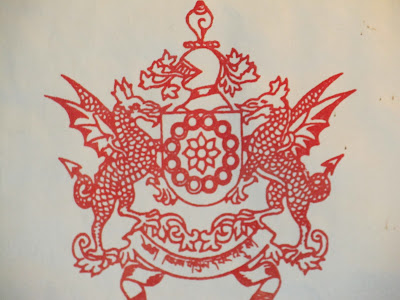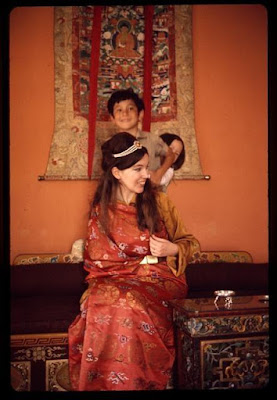 Like any other feudalistic arrangements, the judicial system of
Sikkim has a history of its own. The King though, enjoyed a highest position in
the feudalistic set up, could not execute his judicial obligations properly as
he was surrounded by the then “Elites”, the Kazis,
who were the de-facto arbitrators of
their Ellakas. They could tax,
confiscate, mortgage and sometimes seized the lands of peasants into Home Farm,
the Private land holdings of the Kazis.
In
short, the Kazis were the fountainhead
of justice in feudalistic Sikkim and it is because of such “Lawless Law” the
ordinary peasants were compelled live a combatant’s life.
Like any other feudalistic arrangements, the judicial system of
Sikkim has a history of its own. The King though, enjoyed a highest position in
the feudalistic set up, could not execute his judicial obligations properly as
he was surrounded by the then “Elites”, the Kazis,
who were the de-facto arbitrators of
their Ellakas. They could tax,
confiscate, mortgage and sometimes seized the lands of peasants into Home Farm,
the Private land holdings of the Kazis.
In
short, the Kazis were the fountainhead
of justice in feudalistic Sikkim and it is because of such “Lawless Law” the
ordinary peasants were compelled live a combatant’s life.
Sikkim’s contacts with the British Indian Government had even worsened
the existing judicial system of Sikkim. Available testimonials highlight that
in 1909, the Kazis, Thikadars and Lamas were invested with legal powers by a
State Council Resolution. They could try Civil Suits up to the valuation of Rs.
500/-. The State Council Resolution of 1909 had thus given an overwhelming
power to the state machinery (Kazis, Mandals, Mukhtiyars, Karbaris) to exploit
the common people, especially the peasants in the name of legal action. It is
to be mentioned here that the formation of “British Styled” State Council used
to have the British Political Officer as its President. After the establishment
of the said Council, the Sikkimese Kings were kept behind curtail and the British
Political Officer began to take decisions, enact Laws and to rule the Kingdom with
the assistance of pro-British Kazis like Phodang Lama, Khangsa Dewan and Shoe
Dewan and so on. The Kings whosoever tried to oppose the new set up either were
sent to prison (Maharaja Thotub Namgyal) or were given mysterious death
(Maharaja Sridkyong Trulku). Before the establishment of High Court at Gangtok,
administration of justice in Sikkim was being carried out by the Feudal
Landlords (Adda Courts), Dzongpens
(District Officers). Pipons (Headmen)
and Mandals with the Chogyal at the top.
All the important judgments were given at the Adda Courts and at the
Settlement Houses by the Feudal Officials and used to give inhuman punishments
of Thinguro placed at the Kazi’s House.
These Thinguros were made
up of wooden planks, the culprit had to put his legs inside the hole of the Thinguro, after doing it, the mouth of
the Thinguro was tighten by a rod or
an iron, thus, leaving the culprit standing with utter pain. He could not sit as
the wood was tightened on his knees, therefore he did not have other
alternatives than to cry in the dark prison of the Kazi. Further, he was not
given a single drop of water for three four days, after the Kazi got satisfied
from the punishment, finally he was granted pardon.
In 1916, Appellate Courts by the designation of Chief Court was created
with jurisdiction to try important original suits and also to hear appeals
against the decisions of the Adda Courts. But, from the study it
reveals that there were very few cases of appealing against the decision of the
Adda
Courts due to the threat of havoc from the Kazis and Mukhtiyars. This Court also exercised supervisory and
appellate jurisdiction over the Adda
Courts. The Chief Court was not the final Court. The appeal against the
decision of the Chief Court would lie to the Supreme Court of His Highness, the
Maharaja. The Court of the Maharaja was the final Court of appeal in the State.
It has no original jurisdiction. A Board on the lines of the Judicial Committee
of the Privy Council in England would hear the parties and scrutinize the
evidence regarding merit of the case and then tender its opinion to the
Maharaja. (From the
compilation of Hon’ble Shree A.P Subba, Former Judge High Court of Sikkim)
In 1949, the Adda Courts were abolished on the recommendation of the Judicial
Proposal Committee. The State was divided into 4 (four) revenue Districts and
Magistrates were appointed in District with original and appellate jurisdiction
on the criminal and civil side. The Courts of the Assistant Magistrate and the
Court of Tahsildars were created. In
the lowest rung, a few Honorary Courts of Magistrates were created to dispose
of petty criminal and civil cases. The Chief Magistrate had both original and
appellate jurisdiction on civil and criminal sides. He had unlimited powers
(From the compilation of Hon’ble Shree A.P
Subba, Former Judge High Court of Sikkim).
The independence of India breeds a new hope of liberty inside the
minds of the peasants of Sikkim. They too began to organise themselves in a
larger manner for their rights and liberties. Due to pressure made by Sikkim
State Congress, all the forced labours were wiped out by the reformist Maharaja
Sir Tashi Namgyal in 1948. Further, the overwhelming powers enjoyed by the
Kazis and his Officials were also restrained, indicating a new aeon in the
history of Judiciary of Sikkim. From the available records it appears that in
1953, a Judge of the High Court of Sikkim was appointed but in 1955, High Court
of Judicature (Jurisdiction and Powers) Proclamation, 1955 was issued
establishing a High Court in Sikkim. The High Court thus established was made
the final Court in all judicial matters, civil or criminal, subject to the
exercise of prerogative by the Maharaja to grant mercy, pardon, remission, commutation
and reduction of sentence in case of conviction. The Maharaja had also retained
his prerogative to set up a Special Tribunal
for the review of any case, civil or criminal.
After
becoming the 22nd State of India under Clause (i) of Article 371F, the High
Court functioning immediately prior to the date of merger became the High Court
for the State of Sikkim under the Constitution like any other High Court in the
country. Under Clause (i) of the same Article all Courts of Civil, Criminal and
Revenue Jurisdiction, all Authorities and all Officers, Judicial, Executive and
Ministerial throughout Sikkim were to continue to exercise their respective
powers subject to the provisions of the Constitution and under Clause (k) all
laws in force immediately before the appointed day in Sikkim were to continue
to be in force until amended or repealed by a competent legislature or other
competent authority.









































































